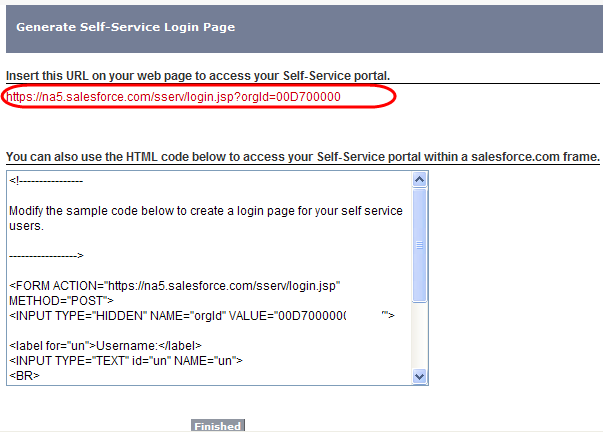Let’s go back to the top of the page on Setup > App Setup > Customize > Self-Service > Self-Service Portal > Settings, and look at the button labeled “Generate HTML.”
You’ve done all this work, so I bet you’re ready to try it out. 🙂
After clicking the “Generate HTML” button you will see at the top of the page the URL to your Self Service portal. Copy and paste that into a browser and try it out! At this point you should do a LOT of testing to make sure it is functioning the way you anticipated.
You can have a link on your company website link to that URL (which will present the User a login page), or you can use the HTML in the middle of the page to give to your webmaster. The HTML is a login fields that can be hosted on your website that upon form submission will send you into the Portal.
Going Live – some final things to consider
This discussion is outside of the scope of how to configure a Self-Service Portal, but consider the following (back to planning!)…
When a Case is created by a Portal User in the Website – what happens? Does it go to a Queue that people are monitoring? Is it routed, using Auto-Assignment Rules, to different individuals based on how the Portal User filled out the case (i.e. Billing questions go to Mary but Technical questions go to Sam, and all others go to Paul)?
Do you want to track aging of Cases, and if a Case ages too long, what needs to happen? Does the Case need to be reassigned to a supervisor? Does someone need to receive an email alert? If aging is important, say you want to have resolution within 24 hours, does the clock stop ticking when your business is closed (meaning, do Escalation Rules observe your business hours of 9am-6pm CST)?
How will Cases be Statused that are created on the SSP? New / Working / Closed? Or something more detailed?
Do you need to build out a Dashboard with reports so you can see what Case volume is coming over the Portal?
You’ll need to train someone in your organization to be the Solutions Manager and ensure their Profile has the right permissions to approve and post Solutions. Back to planning, have a game plan on who can create, submit and publish Solutions. Before being published, ensure there is a process in place that Solutions are being reviewed for technical accuracy, consistent terminology, has your company “voice” (copywriting consistency), and does not conflict or replicate an existing solution (duplicate solution). These will be public documents which are a reflection of your company – that cannot be sloppy or contain poor grammar or use internal vernacular.
You may also need to train your support staff on how to handle Cases that are submitted on the SSP. You will need to have a communication plan internally (to let people in your organization know the service is now available for your customers) and externally (letting your customers know the service is now available).
Lastly – test!
Back to Enabling Users

